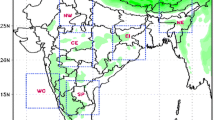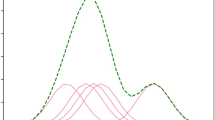Abstract
In this paper, the ensemble-weighted mean (ENSWM) technique is experimented for improving 24- to 72-hr precipitation forecasts over Iran during autumn and winter 2011 and 2012. The ensemble prediction system (EPS), used in this research, consists of nine different configurations of the weather research and forecasting model. In this technique, weights for each ensemble member at each grid point are assigned on the basis of the correlation coefficient (CC) between ensemble members and observed daily rainfall during a training period. Apart from ENSWM, precipitation forecasts using the simple ensemble mean (ENSM) are also generated and compared. Results showed that, in general, the forecast errors are relatively high along the coasts of the Caspian Sea in northern and at the Zagros mountainous areas located in western Iran. The skill of the rainfall forecasts of the ENSWM is examined against ENSM and individual members of the ensemble. The 24- to 72-hr forecasts are evaluated using common statistical scores including root mean-squared error (RMSE), and anomaly CC (ACC) for continuous forecasts and probability of detection (POD) score and threat score for categorical forecasts. The comparison reveals that the ENSWM is able to provide more accurate forecast of rainfall over Iran by taking the strength of each constituent member of the ensemble. It has been further found that the precipitation forecast skill of ENSWM is higher than ENSM and each ensemble member in the short-range time scale over Iran. The rainfall prediction skill over Iran was improved significantly using the weighted ENSWM technique. Results clearly show the advantage of using an EPS for the prediction of precipitation over the country vs. a single deterministic forecast for operational purposes. The RMSE of 24-, 48- and 72-hr forecasts in ENSWM relative to ENSM is reduced by 2, 2 and 5%, respectively. The CC increased by 15% in the ENSWM relative to ENSM.








Similar content being viewed by others
References
Buizza R and Palmer T N 1995 The singular-vector structure of the atmospheric global circulation; J. Atmos. Sci. 52 1434–1456.
Christensen H M, Moroz I M and Palmer T N 2015 Stochastic and perturbed parameter representations of model uncertainty in convection parameterization; J. Atmos. Sci. 72 2525–2544.
Dee D P, Uppala S M, Simmons A J, Berrisford P, Poli P, Kobayashi S, Andrae U, Balmaseda M A, Balsamo G, Bauer P, Bechtold P, Beljaars A C M, van de Berg L, Bidlot J, Bormann N, Delsol C, Dragani R, Fuentes M, Geer A J, Haimberger L, Healy S B, Hersbach H, Hólm E V, Isaksen L, Kållberg P, Köhler M, Matricardi M, McNally A P, Monge-Sanz B M, Morcrette J-J, Park B-K, Peubey C, de Rosnay P, Tavolato C, Thépaut J-N and Vitart F 2011 The ERA-interim reanalysis: Configuration and performance of the data assimilation system; Quart. J. Roy. Meteorol. Soc. 137 553–597.
Delle Monache L, Eckel T, Rife D and Nagarajan B 2013 Probabilistic weather prediction with an analog ensemble; Mon. Weather Rev. 141 3498–3516.
Durai V R and Bhardwaj R 2013 Improving precipitation forecasts skill over India using a multi-model ensemble technique; Geofizika 30(2) 119–141.
Ebert E E 2001 Ability of a poor man’s ensemble to predict the probability and distribution of precipitation; Mon. Weather Rev. 129 2461–2480.
Epstein E S 1969 Stochastic dynamic prediction; Tellus 6 739–759.
Evans R E, Harrison M S J, Graham R J and Mylne K R 2000 Joint medium range ensembles from the Met. Office and ECMWF system; Mon. Weather Rev. 128 3104–3127.
Frogner I-L and Iversen T 2002 High-resolution limited-area ensemble predictions based on low resolution targeted singular vectors; Quart. J. Roy. Meteorol. Soc. 128 1321–1341.
Houtekamer P L, Lefaivre L, Derome J, Ritchie H and Mitchell H L 1996 A system simulation approach to ensemble prediction; Mon. Weather Rev. 124 1225–1242.
Jaiswal N, Kishtawal C M and Bhomia S 2018 Similarity-based multi-model ensemble approach for 1–15-day advance prediction of monsoon rainfall over India; Theor. Appl. Climatol. 132 639–645.
Johnson C and Swinbank R 2009 Medium-range multi-model ensemble combination and calibration; Quart. J. Roy. Meteorol. Soc. 135 777–794.
Krishnamurti T N, Kishtawal C M, Larow T, Bachiochi D, Zhang Z, Willford E C, Gadgil S and Surendran S 1999 Improved weather and seasonal climate forecasts from multimodel superensemble; Science 285 1548–1550.
Krishnamurti T N, Kishtawal C M and Zhang Z et al. 2000 Multi-model ensemble forecasts for weather and seasonal climate; J. Clim. 13(23) 4196–4216.
Krishnamurti T N, Mishra A K, Chakraborty A and Rajeevan M 2009 Improving global model precipitation forecasts over India using downscaling and the FSU superensemble. Part I: 1–5-day forecasts; Mon. Weather Rev. 137 2713–2735.
Kumar A, Mitra A K, Bohra A K, Iyengar G R and Durai V R 2012 Multi-model ensemble (MME) prediction of rainfall using neural networks during monsoon season in India; Meteorol. Appl. 19 161–169.
Leith C E 1974 Theoretical skill of Monte Carlo forecasts; Mon. Weather Rev. 102 409–418.
Masters T 1993 Practical Neural Network Recipes in C++, Academic Press, San Diego, CA, 493p.
Mishra A K and Krishnamurti T N 2007 Current status of multi-model super-ensemble operational NWP forecast of the Indian summer monsoon; J. Earth Syst. Sci. 116(5) 1–16.
Mitra A K, Iyengar G R, Durai V R, Sanjay J, Krishnamurti T N, Mishra A and Sikka D R 2011 Experimental real-time multi-model ensemble (MME) prediction of rainfall during monsoon 2008: Large-scale medium-range aspects; J. Earth Syst. Sci. 120(1) 1–22.
Molteni F, Buizza R, Palmer T N and Petroliagis T 1996 The ECMWF ensemble prediction system: Methodology and validation; Quart. J. Roy. Meteorol. Soc. 122 73–119.
Muller B and Reinhardt J 1991 Neural Networks: An Introduction, the Physics of Neural Networks Series, Springer-Verlag, Berlin, 266p.
Nalder I A and Wein R W 1998 Spatial interpolation of climatic normals: Test of a new method in the Canadian boreal forest; Agric. Forest Meteorol. 92 211–225.
Raftery A E, Gneiting T, Balabdaoui F and Polakowski M 2005 Using Bayesian model averaging to calibrate forecast ensembles; Mon. Weather Rev. 133 1155–1174.
Richardson D S 2001 Ensembles using multiple models and analyses; Quart. J. Roy. Meteorol. Soc. 127 1847–1864.
Romine G S, Schwartz C S, Berner J, Fossell K R, Snyder C, Anderson J L and Weisman M L 2014 Representing forecast error in a convection-permitting ensemble system; Mon. Weather Rev. 142 4519–4541.
Roy Bhowmik S K and Durai V R 2008 Multimodel ensemble forecasting of rainfall over Indian monsoon region; Atmosfera 21(3) 225–239.
Roy Bhowmik S K and Durai V R 2010 Application of multi-model ensemble techniques for real time district level rainfall forecasts in short range time scale over Indian region; Meteorol. Atmos. Phys. 106(1–2) 19–35.
Roy Bhowmik S K and Durai V R 2012 Development of multimodel ensemble based district level medium range rainfall forecast system for Indian region; J. Earth Syst. Sci. 121 273–285.
Soltani M, Laux P, Kunstmann H, Stan K, Sohrabi M M, Molanejad M and Zawar-Reza P 2016 Assessment of climate variations in temperature and precipitation extreme events over Iran; Theor. Appl. Climatol. 126(3–4) 775–795.
Toth Z and Kalnay E 1993 Ensemble forecasting at NMC: The generation of perturbations; Bull. Am. Meteor. Soc. 74 2317–2330.
Toth Z and Kalnay E 1997 Ensemble forecasting at NCEP and the breeding method; Mon. Weather Rev. 125 3297–3319.
Wang X and Bishop C H 2003 A comparison of breeding and ensemble transform Kalman filter ensemble forecast schemes; J. Atmos. Sci. 60 1140–1158.
Wang X, Bishop C H and Julier S J 2004 Which is better, an ensemble of positive–negative pairs or a centered spherical simplex ensemble? Mon. Weather Rev. 132 1590–1605.
Wilks D S 2006 Statistical Methods in the Atmospheric Sciences; 2nd edn, Academic Press, New York, 627p.
Acknowledgements
We would like to show our gratitude to IR of Iran Meteorological Organization (IRIMO) for providing access to the observation data.
Author information
Authors and Affiliations
Corresponding author
Additional information
Corresponding Editor: Kavirajan Rajendran
Rights and permissions
About this article
Cite this article
Fathi, M., Azadi, M., Kamali, G. et al. Improving precipitation forecasts over Iran using a weighted average ensemble technique. J Earth Syst Sci 128, 133 (2019). https://doi.org/10.1007/s12040-019-1145-2
Received:
Revised:
Accepted:
Published:
DOI: https://doi.org/10.1007/s12040-019-1145-2




